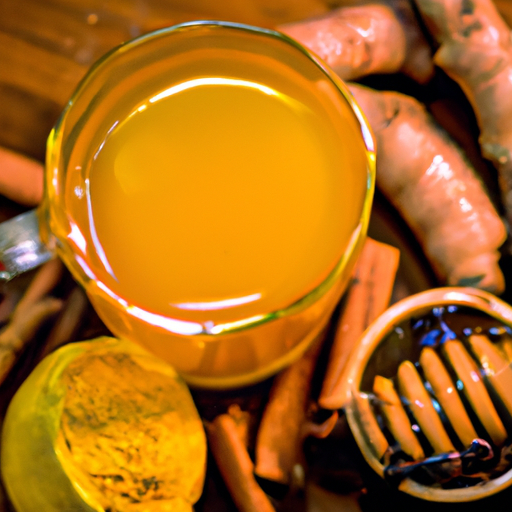Having lived with Crohn’s Disease for many years, I am familiar with the challenges that arise when dealing with the symptoms of this long-term condition. From stomach pain and frequent bowel movements to exhaustion and lack of nutrients, Crohn’s can greatly affect a person’s everyday life.
While there is no cure for Crohn’s Disease, there are various strategies that can help alleviate its symptoms and improve one’s overall well-being. One such strategy is incorporating tea into your diet, as certain types of tea have been found to have anti-inflammatory and antioxidant properties that can benefit those with Crohn’s.
In this article, I will explore the health benefits of tea, the different types of tea available, and the research that has been conducted on tea and Crohn’s Disease. I will also share which types of tea are best for managing Crohn’s symptoms and how to prepare them.
Additionally, I will discuss the precautions that should be taken when drinking tea and other lifestyle changes that can help manage Crohn’s Disease. By the end of this article, you will have a better understanding of how tea can be a beneficial addition to your Crohn’s management plan.
Key Takeaways
- Different types of tea, including black, green, white, and oolong tea, can help alleviate symptoms and improve overall well-being for those with Crohn’s disease.
- Studies suggest that drinking green tea can significantly reduce inflammation in the gut of Crohn’s disease patients.
- Chamomile, peppermint, ginger, fennel, and turmeric tea are beneficial for Crohn’s disease.
- Precautions should be taken when drinking tea, such as considering caffeine sensitivity and potential interactions with medications. Dietary modifications and stress management techniques can complement the benefits of tea and other medications in managing Crohn’s disease.
Overview of Crohn’s Disease
If you’re curious about Crohn’s disease, let’s take a quick look at what it is and how it affects the body.
Crohn’s disease is a type of inflammatory bowel disease (IBD) that can affect any part of the digestive tract, from the mouth to the anus. The exact cause of Crohn’s disease is unknown, but it’s believed to be the result of a combination of genetic and environmental factors.
Common symptoms of Crohn’s disease include abdominal pain, diarrhea, fatigue, rectal bleeding, and weight loss. There’s no cure for Crohn’s disease, but there are treatment options and medications that can help manage symptoms and prevent complications.
The goal of treatment is to reduce inflammation in the digestive tract and alleviate symptoms. Medications such as anti-inflammatory drugs, immunosuppressants, and antibiotics can be used to achieve this. In severe cases, surgery may be necessary to remove damaged portions of the digestive tract.
With that said, there are natural ways to alleviate symptoms of Crohn’s disease, such as drinking tea.
Health Benefits of Tea
You’ll be surprised to know that drinking a cup of tea every day can reduce your risk of heart disease by 20%. Tea, especially green tea, is rich in antioxidants that help protect your cells from damage caused by free radicals. These antioxidants may also help reduce inflammation in the body, which is beneficial for those with Crohn’s disease.
If you’re a coffee lover, don’t worry! You don’t have to give up your beloved cup of joe completely. However, incorporating tea into your daily routine can have significant health benefits. Here are a few reasons why tea is a great substitute for coffee:
- Tea contains less caffeine than coffee, which can help reduce anxiety and jitters.
- Tea is a natural source of L-theanine, an amino acid that promotes relaxation and reduces stress.
- Tea is available in a variety of flavors and types, making it easy to find one that suits your taste preferences.
In addition to its benefits for those with Crohn’s disease, tea is a great beverage choice for anyone looking to improve their overall health.
In the next section, we’ll explore the different types of tea and their unique health benefits.
Types of Tea
I’m excited to talk about the different types of tea and their unique characteristics.
Black tea, with its bold flavor and high caffeine content, is a great pick-me-up in the morning.
Green tea, known for its health benefits, is a light and refreshing option that can be enjoyed throughout the day.
White tea, the least processed of all teas, has a delicate flavor and is rich in antioxidants.
Finally, oolong tea, with its partially oxidized leaves, offers a complex flavor profile that’s perfect for those who enjoy a more sophisticated taste.
Black Tea
Black tea can be a delicious and potentially helpful option for individuals with Crohn’s disease. It’s a type of tea that’s fully oxidized, resulting in a stronger flavor than other tea varieties.
Black tea contains compounds called theaflavins and catechins, which have anti-inflammatory properties. These compounds may help reduce inflammation in the gut, which is a common problem for individuals with Crohn’s disease.
In addition, black tea has other health benefits, such as improving heart health and reducing the risk of certain types of cancer. However, it’s important to note that black tea also contains caffeine, which can be a trigger for some individuals with Crohn’s disease.
As with any dietary change, it’s important to consult with a healthcare provider before incorporating black tea into your diet.
Next, we’ll discuss green tea and its potential benefits for individuals with Crohn’s disease.
Green Tea
One potential option for individuals with Crohn’s disease is green tea, which has been found to have anti-inflammatory properties and may help reduce inflammation in the gut. Green tea contains a compound called epigallocatechin-3-gallate (EGCG), which has been shown to have anti-inflammatory effects. Additionally, the antioxidants in green tea can help protect the body from damage caused by free radicals.
If you’re considering incorporating green tea into your daily routine, here are some potential discussion ideas to consider:
- Benefits: Green tea may have anti-inflammatory properties, may help reduce the risk of developing colorectal cancer, and contains antioxidants.
- Drawbacks: Green tea contains caffeine, which may aggravate symptoms in some individuals.
- How to incorporate into a daily routine: Try swapping out your morning coffee for a cup of green tea, or enjoy a cup in the afternoon as a mid-day pick-me-up.
- Recommended dosage: There’s no set recommended dosage for green tea, but it’s generally recommended to stay within moderate levels of consumption.
- Potential interaction with medications: Green tea may interact with certain medications, so it’s important to speak with your healthcare provider before adding it to your routine.
Moving on to the next subtopic, white tea also has potential benefits for those with Crohn’s disease.
White Tea
White tea, known for its delicate flavor and high levels of antioxidants, has the potential to alleviate symptoms of inflammatory conditions like Crohn’s disease. The antioxidants found in white tea are called catechins, and they’ve been shown to reduce inflammation in the body.
In addition, white tea contains polyphenols which have been found to have anti-inflammatory effects as well. These benefits make white tea a great choice for those with Crohn’s disease who are looking for a natural way to manage their symptoms.
When brewing white tea, it’s important to use water that isn’t too hot, as boiling water can damage the delicate flavor and nutrients in the tea. A temperature of 170-180°F is ideal for brewing white tea.
Steeping time should also be kept short, around 2-3 minutes, to prevent the tea from becoming too bitter. By brewing white tea properly, you can enjoy its full range of health benefits and delicate flavor.
Moving on to the next topic, oolong tea has been shown to have potential benefits for those with Crohn’s disease as well.
Oolong Tea
If you’re looking for a flavorful option with potential health benefits, oolong tea might be your cup of choice, as it’s been known to soothe your digestive system like a gentle breeze on a warm day.
Originating in China, oolong tea is made from partially fermented tea leaves and has a unique taste that falls between green tea and black tea. It’s been enjoyed for centuries and has been said to provide numerous health benefits.
Here are four interesting facts about oolong tea:
- Oolong tea has been associated with weight loss due to its ability to increase metabolism and burn fat.
- The fermentation process of oolong tea may help relieve symptoms of digestive disorders such as Crohn’s disease.
- Oolong tea contains antioxidants that may help reduce the risk of chronic diseases such as heart disease and cancer.
- The caffeine and theanine in oolong tea may help improve brain function and increase alertness.
Research on tea and Crohn’s disease is still ongoing, but the potential health benefits of oolong tea make it a great option for those with digestive issues.
Research on Tea and Crohn’s Disease
You’ll be pleased to know that studies suggest drinking green tea may help reduce inflammation in the gut and alleviate symptoms of Crohn’s disease.
In fact, a clinical trial conducted in Japan found that drinking green tea for 12 weeks significantly reduced inflammation in the gut of Crohn’s disease patients.
Additionally, a study published in the Journal of Gastroenterology and Hepatology found that green tea polyphenols (compounds with antioxidant properties) can modulate the gut microbiome, which plays a crucial role in the development of inflammatory bowel disease.
Comparing tea and traditional Crohn’s disease treatments, it’s important to note that while tea may help alleviate symptoms, it should not be used as a sole treatment for Crohn’s disease. Rather, it can be used in conjunction with medication and lifestyle changes to manage symptoms.
In the next section, we’ll dive into the best tea options for individuals with Crohn’s disease.
Best Tea for Crohn’s Disease
For a soothing and gentle option to help ease your gut discomfort, sipping on a warm cup of tea can be like a comforting hug for your insides. When it comes to Crohn’s disease, there are a variety of herbal alternatives that can be beneficial. Chamomile tea is a popular option for its anti-inflammatory properties and ability to calm the digestive system. Peppermint tea is another favorite, as it can help alleviate symptoms such as bloating and gas. Other teas that have been known to help with Crohn’s include ginger, fennel, and turmeric tea.
To help you choose the best tea for your symptoms, below is a table outlining the benefits of each tea and brewing techniques to ensure maximum effectiveness. Remember, it is important to consult with your healthcare provider before incorporating any new remedies into your treatment plan.
| Tea | Benefits | Brewing Technique |
|---|---|---|
| Chamomile | Anti-inflammatory, Calming | Steep 1-2 teaspoons in hot water for 5-10 minutes |
| Peppermint | Alleviates bloating and gas | Steep 1-2 teaspoons in hot water for 5-10 minutes |
| Ginger | Anti-inflammatory, Calming | Add 1-2 teaspoons of grated ginger to hot water and let steep for 10-15 minutes |
| Fennel | Alleviates bloating and gas | Steep 1-2 teaspoons in hot water for 5-10 minutes |
| Turmeric | Anti-inflammatory | Add 1-2 teaspoons of turmeric powder to hot water and let steep for 5-10 minutes |
Now that you know the benefits and brewing techniques of each tea, the next section will discuss how to prepare tea to ensure the best results for your gut health.
How to Prepare Tea
When it comes to preparing tea, there are a few key factors to consider in order to get the perfect cup.
Firstly, it’s important to choose the right tea leaves for your desired taste and health benefits.
Secondly, brewing temperature and time can greatly affect the flavor and strength of your brew.
Finally, adding honey or lemon can enhance the taste and provide additional health benefits.
By considering these factors, you can create a delicious and healthy cup of tea.
Choosing the Right Tea Leaves
If you’re looking to choose tea leaves that can potentially alleviate symptoms of Crohn’s disease, it’s important to consider the specific types of tea and their potential benefits. Here are a few things to keep in mind when selecting the right tea leaves:
-
Look for teas with anti-inflammatory properties. These teas can reduce inflammation in the gut, which is especially important for those with Crohn’s disease. Green tea, white tea, and oolong tea are all good options.
-
Consider the tea flavor. Since Crohn’s disease can affect the taste buds, it’s important to choose a tea that you enjoy drinking. Some people find that fruity or floral teas are more palatable than strong, bitter teas.
-
Choose high-quality tea leaves. Lower quality tea leaves may be contaminated with pesticides or other harmful substances, which can aggravate Crohn’s disease symptoms. Look for organic and/or fair-trade options.
-
Experiment with different types of tea. Everyone’s body is different, so what works for one person may not work for another. Don’t be afraid to try different types of tea to see what works best for you.
When it comes to choosing tea leaves for Crohn’s disease, it’s all about finding a balance between taste and health benefits. Once you’ve selected the right tea leaves, it’s time to move on to the next step: brewing temperature and time.
Brewing Temperature and Time
To get the most out of your chosen tea leaves, make sure to adjust the brewing temperature and time according to your preference. Brewing equipment also plays a role in the quality of your tea. Using high-quality equipment can enhance the taste and aroma of your tea.
When it comes to brewing temperature and time, it’s important to find the right balance. Steeping tea for too long can result in a bitter taste, while steeping it for too short a time can result in a weak flavor. The table below provides a general guide for brewing temperatures and times for different types of tea. Keep in mind that these are just guidelines, and you should adjust them based on your personal preference.
| Type of Tea | Water Temperature | Brewing Time |
|---|---|---|
| Green | 160-180°F | 1-3 minutes |
| White | 170-185°F | 2-3 minutes |
| Oolong | 190-200°F | 3-5 minutes |
| Black | 200-212°F | 3-5 minutes |
Adjusting the brewing temperature and time can make a significant difference in the taste and quality of your tea. Once you’ve brewed your tea to your liking, you may want to add honey or lemon to enhance the flavor.
Adding Honey or Lemon
Enhance the flavor of your brew by adding a touch of honey or a squeeze of lemon, creating a deliciously sweet and tangy taste. Not only do these additions add depth to your tea, but they also have potential health benefits for those with Crohn’s disease.
Here are a few benefits of honey and lemon alternatives for Crohn’s disease:
- Honey has antibacterial and anti-inflammatory properties that may help soothe inflammation in the gut.
- Lemon contains vitamin C, which can help boost the immune system and reduce inflammation.
- Adding lemon to tea can also help aid in digestion by increasing the production of stomach acid.
- Honey and lemon together can help soothe a sore throat and alleviate coughing.
- For those who cannot tolerate honey, maple syrup can be used as a substitute for its anti-inflammatory properties.
Incorporating these simple additions to your tea not only enhances the flavor but also provides potential health benefits for those with Crohn’s disease. As we move forward, let’s discuss how to incorporate tea into your diet in a sustainable and enjoyable way.
Incorporating Tea into Your Diet
Incorporating tea into your diet is a simple and enjoyable way to boost your overall health and well-being. Not only is tea brewing easy, but there are also countless tea flavors to choose from to suit your taste buds.
From green tea to herbal tea, there is a tea for everyone. When it comes to Crohn’s disease, certain teas may be more beneficial than others. For instance, chamomile tea has anti-inflammatory properties that may help reduce inflammation in the gut. Peppermint tea may also help soothe stomach discomfort and reduce bloating.
However, it’s important to note that not all teas may be suitable for everyone with Crohn’s disease. Therefore, it’s important to consult with your doctor or a registered dietitian before incorporating tea into your diet.
Precautions When Drinking Tea
As someone who enjoys drinking tea on a regular basis, it’s important to be aware of potential precautions when consuming this beverage.
For individuals with caffeine sensitivity, it’s important to monitor their intake as some teas can contain high amounts of caffeine.
Additionally, certain teas may interact with medications and it’s important to consult with a healthcare provider before consuming them.
By being mindful of these precautions, tea can be enjoyed safely and without any adverse effects.
Caffeine Sensitivity
While it might be tempting to reach for a cup of coffee or black tea, individuals with Crohn’s disease who are sensitive to caffeine may want to consider caffeine alternatives. Caffeine can act as a stimulant and increase bowel movements, which can worsen symptoms of Crohn’s disease.
Some caffeine alternatives include herbal teas, such as peppermint, chamomile, and ginger, which have anti-inflammatory properties and can help soothe the digestive tract. Additionally, decaffeinated teas or those with lower amounts of caffeine, such as green tea or white tea, may be better tolerated by those with Crohn’s disease.
Managing caffeine intake is important for individuals with Crohn’s disease, as excessive caffeine consumption can lead to dehydration and interfere with medication absorption. It’s recommended to limit caffeine intake to no more than 400mg per day, which is equivalent to about 4 cups of coffee.
It’s important to note that caffeine sensitivity can vary from person to person, so it’s best to listen to your body and adjust accordingly. By incorporating caffeine alternatives and managing caffeine intake, individuals with Crohn’s disease can help alleviate symptoms and improve their overall quality of life.
In addition to caffeine sensitivity, it’s important to consider how tea and other beverages may interact with medications used to treat Crohn’s disease.
Interactions with Medications
Be cautious of how other beverages may interact with your medication, as it could potentially worsen your symptoms and hinder your progress towards healing. While tea may have many potential benefits for Crohn’s disease, it’s important to be aware of any potential risks or interactions with your current medications.
Some teas contain compounds that can affect the way your body absorbs or metabolizes medication, which can lead to negative side effects or reduced effectiveness. When incorporating tea into your Crohn’s disease management plan, it’s important to discuss dosage recommendations and potential interactions with your healthcare provider. They can help you determine which teas may be beneficial for your specific condition and medications, as well as any precautions you need to take to avoid potential negative interactions.
By being mindful of how tea may interact with your medications, you can safely incorporate this beverage into your Crohn’s disease management plan and potentially experience its many benefits. Furthermore, there are other lifestyle changes that can also help manage Crohn’s disease. These changes include dietary modifications and stress management techniques, which can complement the benefits of tea and other medications.
Other Lifestyle Changes to Manage Crohn’s Disease
When managing my Crohn’s disease, I’ve found that making lifestyle changes beyond just drinking tea can be incredibly helpful.
Three key areas that I focus on are diet and nutrition, stress management, and exercise.
By paying attention to what I eat, finding ways to reduce stress, and incorporating regular physical activity into my routine, I’ve been able to better manage my symptoms and improve my overall quality of life.
Diet and Nutrition
To manage my Crohn’s disease, I focus on eating a balanced diet that includes plenty of fruits, vegetables, lean proteins, and whole grains. Nutritional recommendations for Crohn’s disease include avoiding trigger foods like dairy, spicy foods, and high-fat foods. I also make sure to stay hydrated by drinking plenty of water throughout the day.
Incorporating green tea into my diet has also been shown to help reduce inflammation and improve gut health. Green tea contains antioxidants called catechins that have anti-inflammatory properties. Additionally, green tea has been found to promote the growth of good gut bacteria, which can help improve digestion and overall gut health.
By paying attention to my diet and incorporating green tea, I can better manage my Crohn’s disease and improve my quality of life. Transitioning into the subsequent section about stress management, it’s also important to remember that stress can also play a role in Crohn’s disease symptoms.
Stress Management
One way I’ve found helpful in managing my Crohn’s disease symptoms is by taking steps to reduce stress in my daily life. Stress can exacerbate symptoms and trigger flare-ups, so finding ways to relax and unwind is crucial.
Some techniques that have worked for me include practicing meditation, deep breathing exercises, and progressive muscle relaxation. Meditation techniques can help focus the mind and reduce anxiety, which can, in turn, help alleviate stress. There are many different types of meditation, so it’s important to find one that works for you.
Deep breathing exercises involve taking slow, deep breaths to calm the body and mind. This can be done anywhere, anytime, and is a quick and easy way to reduce stress. Progressive muscle relaxation involves tensing and then relaxing different muscle groups, which can help release tension and promote relaxation.
By incorporating these techniques into my daily routine, I’ve found that my stress levels have decreased, and my Crohn’s disease symptoms have improved.
Reducing stress is just one aspect of managing Crohn’s disease. Another important step is incorporating exercise into your routine.
Exercise
Incorporating regular exercise into your routine can be a game-changer for managing Crohn’s symptoms. Not only does it help improve digestion, but it also reduces inflammation and boosts overall health and well-being.
One form of exercise that’s been particularly beneficial for individuals with Crohn’s disease is yoga. The benefits of yoga for Crohn’s patients are numerous.
Yoga helps to reduce stress and anxiety, which can trigger symptoms. In addition, yoga postures can improve digestion and circulation, which can help alleviate symptoms such as bloating and constipation.
It’s important to note that rest is also a crucial component of managing Crohn’s disease. Incorporating yoga into your routine can provide both physical activity and relaxation, making it a great addition to a Crohn’s management plan.
Frequently Asked Questions
What are the common symptoms of Crohn’s disease and how can they be managed?
As someone with Crohn’s disease, I manage my symptoms through dietary recommendations and medications. Common symptoms include abdominal pain, diarrhea, and fatigue. Working closely with a healthcare provider is important for effective management.
Are there any foods or beverages that should be avoided when managing Crohn’s disease?
As someone managing Crohn’s disease, it’s important to be mindful of dietary restrictions and avoid trigger foods. Certain foods like spicy or high-fiber foods may exacerbate symptoms. It’s best to work with a healthcare provider or registered dietitian to create a personalized plan.
Can tea be used as a substitute for medical treatment in managing Crohn’s disease?
Tea cannot be used as a substitute for medical treatment in managing Crohn’s disease. While tea may offer some benefits, it does not compare to the effectiveness of medication prescribed by a healthcare professional.
How can stress and anxiety affect Crohn’s disease and what can be done to manage them?
Stress and anxiety can worsen Crohn’s disease symptoms. To manage them, I practice breathing exercises and meditation techniques. Evidence suggests they can reduce inflammation and improve quality of life. I prioritize stress management alongside medical treatment.
Are there any alternative therapies or remedies that can be used in conjunction with tea to manage Crohn’s disease?
Oh, sure. Because when I think of managing my Crohn’s disease, the first thing that comes to mind is herbal remedies and acupuncture. But, in all seriousness, some studies suggest that these alternative therapies can be helpful in conjunction with traditional treatments.
Conclusion
So, what tea is good for Crohn’s Disease?
After researching the topic, I’ve found that green tea and chamomile tea are the best options. Both teas have anti-inflammatory properties that can help reduce symptoms of Crohn’s Disease.
However, it’s important to note that tea shouldn’t be used as a replacement for prescribed medication or treatment. Incorporating tea into your diet can be a simple and enjoyable way to manage symptoms of Crohn’s Disease.
By preparing and drinking tea regularly, you can potentially reduce inflammation and discomfort in your digestive system. So, why not give it a try? Who knows, a cup of tea may just be the natural remedy you’ve been looking for.










